Openings #5: Flank Openings
A review
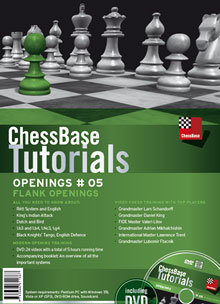 Continuing its best-selling series “ChessBase Openings Tutorials”, the fifth volume has been released covering the slightly enigmatic ‘Flank Openings’. The reason I call it enigmatic, is because contrary to the clear-cut ‘open games’ stemming from 1.e4 e5, or closed games from 1.d4 d5, flank openings are not so easily defined, and involve areas of development (the flanks obviously), as opposed to only two first moves.
Continuing its best-selling series “ChessBase Openings Tutorials”, the fifth volume has been released covering the slightly enigmatic ‘Flank Openings’. The reason I call it enigmatic, is because contrary to the clear-cut ‘open games’ stemming from 1.e4 e5, or closed games from 1.d4 d5, flank openings are not so easily defined, and involve areas of development (the flanks obviously), as opposed to only two first moves.
Among the openings are respectable main streams such as the English Opening, the Dutch Defense, the Reti, as well as systems such as the King’s Indian Attack, not to mention more offbeat openings, still popular in club play, such as the Sokolsky (1.b4) or the Grob (1.g4).
The purpose of the tutorial series is to provide a summarized run-through of all these openings and lines in videos ranging from ten to fifteen minutes on average, allowing players still undecided on what opening they wish to invest in, to get a feel for the moves and ideas.
As in the previous volumes, there are two complete series of videos in both English and German, meaning that if you are able to follow both languages, you are getting 48 videos in all. Each series consists of 24 videos presented by experienced grandmasters and masters, and while they cover the same openings and lines, the variations chosen and even historic information, varies according to the presenter.
For example, covering the Larsen Opening in English is IM Lawrence Trent, who explains that 1.b3 was originally introduced by Nimzowitsch in the 1920s, and its main value is that it is a sensible opening that will most likely force the opponent to think on his own.
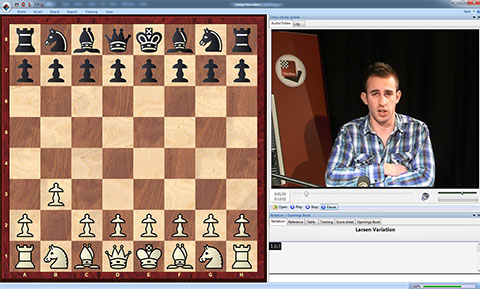
IM Lawrence Trent presents the Larsen Opening to the English speaking audience
In the German video by IM Martin Breutigam we are told that it earned the name after Larsen brought it back to grandmaster practice in the 60s to great effect. Breutigam agrees that its main value is the good chance it has not been studied deeply by the opponent, and he emphasizes its flexibility. All in all, it is clear that while one will certainly be well served by either IM Trent or IM Breutigam, together they will give a much more comprehensive picture.
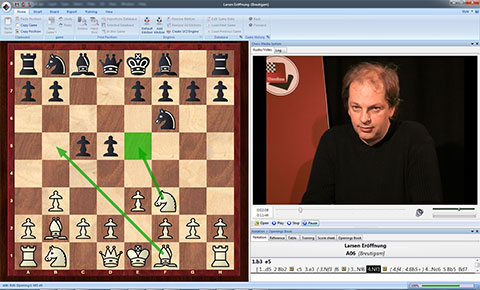
IM Martin Breutigam shares insights on the Larsen Opening with the German viewers
Still, it must be said that the German viewers do have an advantage in at least two opening videos, notably the ones covering the Bird (1.f4) and the Sokolsky (1.b4). No disrespect meant to either IM Trent or FM Lilov who do a very creditable job, but they cannot compare to the charming IM Elizabeth Paetz. I’d recommend viewing them even if you don’t speak German.

The lucky German viewers get to enjoy IM Elizabeth Paetz's friendly presentation
Overall the video presentations provide a good overview of the various openings, providing the main theoretical lines as well as the main ideas behind them. The masters all have their own recommendations and style of presentation, but are clear and objective, and should allow the casual club player to use them to good effect, or learn enough to choose an opening for deeper study.
The 24 openings and variations covered are:
- English - 1.c4 e5 2.Nc3 d6/Bb4
- English - 1.c4 e5: Botvinnik System
- English - 1.c4 e5: Four Knights
- English - 1.c4 e5: Reversed Dragon
- English - 1.c4 c5 2.Nf3 Nf6 3.d4 cxd4 4.Nxd4
- English - 1.c4 c5 2.Nc3 Nf6 3.Nf3/g3 d5
- English - Fianchetto variation
- Nimzo-English and Queen's Indian patterns
- Flohr-Mikenas Attack
- Reti: Piece pressure on the centre
- Reti: Open Variation
- Reti: Closed System
- Reti: Advance Variation
- King's Indian Attack: After 1.e4
- King's Indian Attack: After 1.Nf3
- Dutch: Classical Variation
- Dutch: Stonewall
- Dutch: Leningrad System
- Bird Opening
- Larsen Opening
- Sokolsky (1.b4)
- Black Knights' Tango
- Van Geet (1.Nc3)
- Grob's Attack (1.g4)
- English Defence
Those who purchase the physical DVD will also receive a booklet in the same style and quality as the one that accompanies each issue of ChessBase Magazine. However, those who opt for the digital download version will not be short-changed as their downloads will include a PDF version of the booklet which can be viewed at anytime.
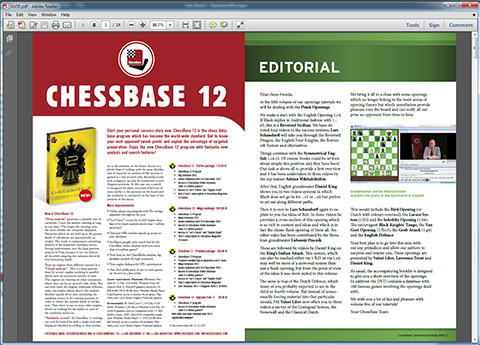
The booklet can be seen as a PDF document for those who purchase the digital download
Out of curiosity, I tallied the times of each video and was impressed to see that the English videos alone reached a total run time of nearly five hours. Presumably the German versions are of similar depth and length, making this series one of the best values there are if quantity of content is any measuring stick.
If you are seeking to learn about one of these openings, and want something brief and to the point for you next club match, or just something to spring in your blitz games, there is plenty of good material to experiment with here. Should you choose to develop one or other in particular, it goes without saying that ChessBase offers ample options for the budding player. All in all, an excellent buy.
Click here to purchase ChessBase Tutorials Openings #5: Flank Openings.
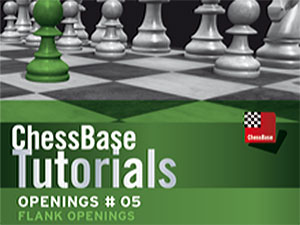

















 Continuing its best-selling series “ChessBase Openings Tutorials”, the fifth volume has been released covering the slightly enigmatic ‘Flank Openings’. The reason I call it enigmatic, is because contrary to the clear-cut ‘open games’ stemming from 1.e4 e5, or closed games from 1.d4 d5, flank openings are not so easily defined, and involve areas of development (the flanks obviously), as opposed to only two first moves.
Continuing its best-selling series “ChessBase Openings Tutorials”, the fifth volume has been released covering the slightly enigmatic ‘Flank Openings’. The reason I call it enigmatic, is because contrary to the clear-cut ‘open games’ stemming from 1.e4 e5, or closed games from 1.d4 d5, flank openings are not so easily defined, and involve areas of development (the flanks obviously), as opposed to only two first moves.








